Ch 29: Fungi
1/30
There's no tags or description
Looks like no tags are added yet.
Name | Mastery | Learn | Test | Matching | Spaced |
|---|
No study sessions yet.
31 Terms
What are the characteristics of all fungi?
Eukaryotic: Unicellular and multicellular (branching networks of multicellular filaments)
Heterotrophs: Carbon and Energy from other organisms (living or dead organic matter)
All use Alternation of generations
What are the ways fungi can be heterotrophs?
Decomposers
Parasitic (+/-) - diseases in animals, plants, parasite insects
Mutualism (+/+)
Why are fungi being decomposers so important to the global carbon cycle?
Basically, along w/ a few bacteria, fungi are the only organisms that can digest wood completely. If this process does not occur, carbon remains trapped in wood. Without fungi, carbon dioxide would be tied up and unavailable for photosynthesis and the presence of undecayed organic matter would reduce the space available for plants to grow
What are some of the mutualistic relationships found in fungi?
Roots of most land plants are colonized by an array of mutualistic fungi that provide water and key nutrients (nitrogen, phosphorus) to the host plant
Fungi living inside the shoots of certain plants help ward off herbiovers bymaking toxic compounds
Many insects harbor single-celled fungi in their guts that aid their digestion of plant material
Fill in the Blank: Fungi that live in close association are said to be _________ and fungi along with the roots they are associated with are called ______
Mycorrhizal
Mycorrhizae
What are fungi that make their living by digesting dead plant material?
Saprophytes
What are the chemicals secreted by soil fungi which inhibit the growth of bacteria?
Antibiotics
What are the morphological traits of fungi?
Their simple bodies
Presence of Hyphae in Mycelia
Type of reproductive structure
Type of Reproduction
Fungi’s close tie to animals
What are the two growth forms of fungi?
Yeasts - single-celled fungi
Mycelia - multicellular, filamentous structures
Mycelia: What are hyphae?
Long, narrow filaments that make up a mycelium
Mycelial Hyphae: In most terrestiral fungi, each filament is divided into cells by cross wall called…..
Septa
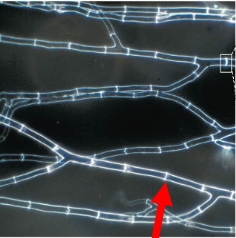
Mycelial Hyphae: What are the significance of pores in separate hyphae?
Pores – gaps that enable a wide variety of materials even nuclei and other organelles to flow from one cell-like compartment to the next
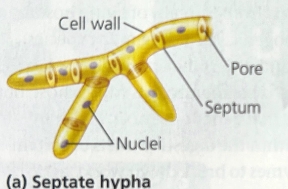
True or False: Hyphae can be coenocytic, which means filaments are not divided into separate cells and lack septa entirely, which can have hundreds or thousands of nuclei scattered throughout the mycelium
True
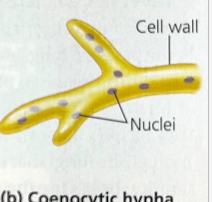
True or false: Mycelia have a large surface area which makes mycelia very thin and can cause it to dry quickly
True
True or False: Since mycelia is so thin, it always dries out
False; mycelia fungi produce reproductive cells called spores that are resistant to drying, so spores can endure dry periods and then germinate to form a new mycelium when conditions improve
What is also true about fungi?
Mycelial growth is dynamic, changing w/ moisture availability and food supply
Mycelia support external digestion and the absorptive lifestyle of fungi
What are the 4 ways sexual reproduction can occur in fungi?
Swimming gametes and spores
Zygosporangia
Basidia
Asci
Sexual Reproduction: What are chytrids?
Species w/ swimming gametes/spores
In water/wet species, the gametes or spores produced during sexual reproduction have flagella
These are the only motile cells known in fungi
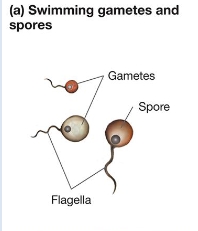
Sexual Reproduction: What are zygomycetes?
Haploid hyphae from 2 individuals meet and become joined, cells from yoked hyphae fuse to form a distinctive spore-producing structure (zygosporangium)
Known as zygomycetes

Sexual Reproduction: What are basidiomycetes, or club fungi?
Mushrooms (etc) form specialized club-shaped cells at the ends of hyphae called basidia and each basidium produces four spores by meiosis
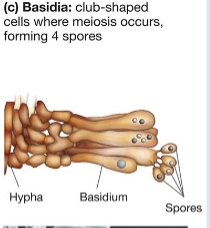
Sexual Reproduction: What are asci, or sac fungi?
when fungi form specialized sac-like cells called asci at the tips of hyphae, and w/i each ascus, meiosis and one round of mitosis produces 8 spores
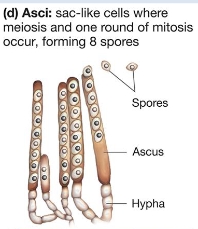
How does asexual reproduction happen in fungi?
Asexual spores called conidia and conidia can be dispersed by water or wind currents and grow into new hyphae when conditions are right
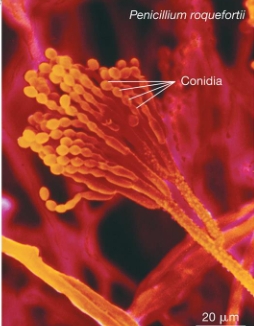
What are the 3 key traits that link animals and fungi?
Many animals and most fungi synthesize the tough structural material called chitin (Chitin is a prominent component of the cell walls of fungi)
The flagella that develop in chytrid spores and gametes are similar to those observed in animals
Both animals and fungi store food by synthesizing glycogen (both are heterotrophic)
How does alternation of generations work in fungi?
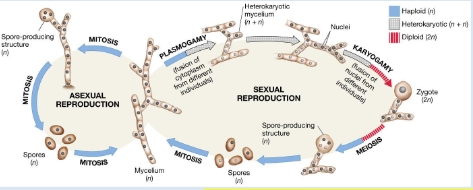
Key Lineages of Fungi: Microsporidia Characteristics
Known Species: 1500
Absorptive Life Style: all are parasites of animal's cells, especially in insects or fish, where the fungi enter the host cell through a polar tube which microsporidian shoots into host cell
Life Cycle: Some appear to reproduce only asexually while others produce various types of sexual spores (Some infect several hosts to complete the life cycle)
Common examples: Many species can infect humans but only do damage on immuno-compromised victims, pests in honeybee/silkworm colonies
Key Lineages of Fungi: Chytrids Characteristics
Habitat: Aquatic, common in fresh water
Known Species: 750
Absorptive Life Style: Many decompose plants by digesting cellulose, while others have mutualistic relationships in guts of some animals to help plant digestion, and some are parasitic which infect many animals and plants
Life Cycle: the only fungi that produces motile cells (both their spores/gametes swim w/ flagella) and most exhibit alternation of generations
Common examples: Batrachochytrium Dendrobatidis – disease caused by the fungus which infects frogs/amphibians
Key Lineages of Fungi: Zygomycetes Characteristics
Habitat: Food molds
Know Species: 1050
Absorptive Life Style: Many are saprophytes and live on plant debris, some are parasites on fungi, insects, or spiders
Life Cycle: Asexual reproduction commonly used by have asexual sporangia that produce spores but sexual reproduction can happen through the fusion of hyphae and formation of zygosporangium and sexual sporangia
Common Examples: Bread, soft fruit molds
Key Lineages of Fungi: Glomeromycetes Characteristics
Known Species: 200
Absorptive Lifestyle: Form mutualistic associations w/ plant roots in the form of arbscular mycorrhizal fungi (AMF)
Life Cycle: Most produce large spores but reproduction is difficult to grow and study, like as sexual reproduction has not be observed yet
Common Examples: AMFs contact plasma membranes of root cells, and many other play large roles in the ecology of prairies and tropical forests
Key Lineages of Fungi: Basidiomycota Characteristics
Known Species: 32000
Absorptive Lifestyle: Decompose wood by producing lignin peroxidase; some form ectomycorrhizal associations w/ tree roots; smut and rust fungi are plant parasites
Life Cycle: Produce haploid spores in club-shaped basidia; basidia of mushroom-forming species live in gills found under the cap
Common examples: Mushrooms, puffballs, brackets
What are the fruiting bodies in basidiomycotas?
Basidium
Key Lineages of Fungi: Ascomycota Characteristics
Known Species: 64000
Absorptive Life Style: Many form ectomycorrhizal associations w/ tree roots; some form mutualistic associations w/ photosynthetic algae or bacteria in lichens; some are predatory on protists or nematodes
Life Cycle: Produce haploid spores in sac-like asci; asci of many species found of fleshy, cup-shaped structures; many use asexual reproduction
Common Examples: Lichens are often sensitive to air pollution and are used as bioindicators, yeasts, penicillin
Morels – fruiting body, above ground fungal portion
Truffles – associated w/ roots of particular tree species (mutualistc mycorrhizae) and their fruiting bodies are attached to belowground mycelium, give off odors attracted to some animals, horrible for farmers
Blights, mildews, ergot, insect pathogens